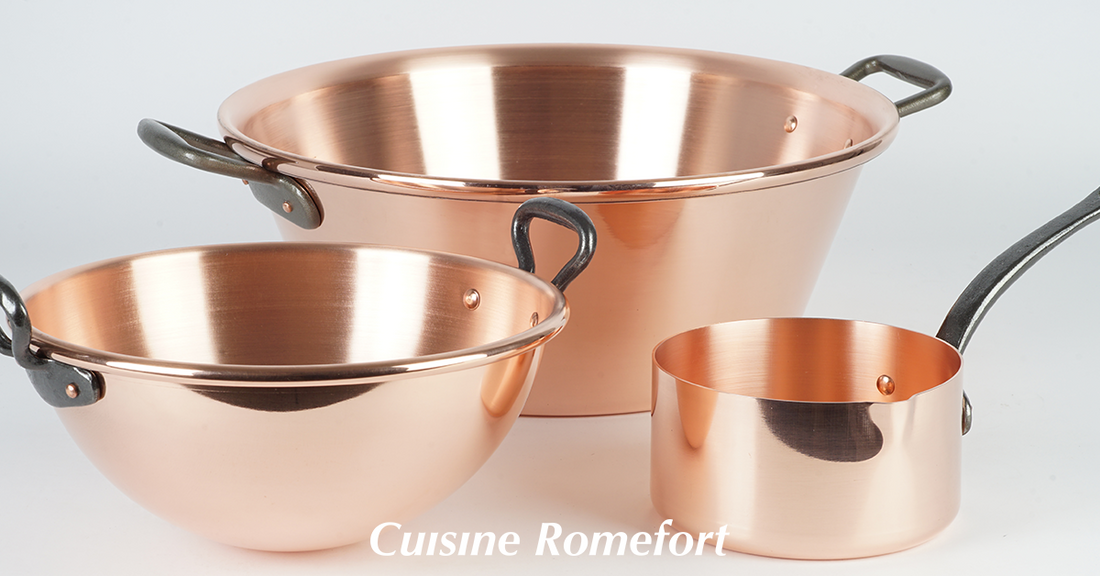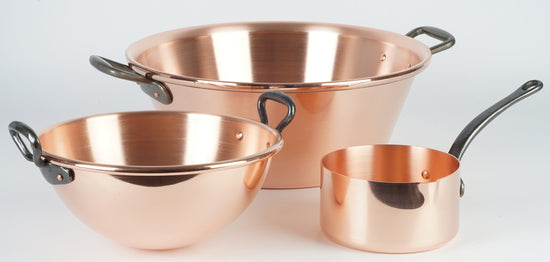

-
In this article you will find information regarding
► the positive properties of copper,
► the different types of copper dishes,
► the cooking and handling of copperware,
► the care of copper dishes.
The positive characteristics of copper when preparing meals
-
The preparation of food with copper cookware
Copper has been used and cherished for around 9,000 years. Pots that are made of copper are ideal heat conductors; the material is durable, hygienic and corrosion-resistant. Above all, it is the excellent heat conductivity that makes copper a perfect base material for pots and pans. It is widely known that copper conducts heat five times better than iron and even twenty times better than stainless steel. Thanks to the excellent heat conductivity properties, the heat spreads more evenly in copper cookware than in traditional pots and pans. This also reduces the danger of scorching since the temperature can be regulated more easily. As a result, it is possible to cook with less energy. All in all you have the best control over the temperature of your food in copper cookwear!
-
Copper cookware and hygiene - copper is antibacterial
Copper cookware has an antibacterial effect because germs and bacteria cannot survive on copper. For these microorganisms copper is toxic but to humans the material poses no threat at all. For this reason, water pipes and door handles in hospitals are often made of copper. As a consequence, the transmission of germs can be avoided.
The different types of copper cookware
-
Products sold as copper cookware are not always made of pure copper. Unfortunately you will find a lot of cheap products made with a thin layer of copper which do not benefit from the cooking properties mentioned above. Make sure your copper pot is at least 95% copper and not an aluminum or stainless steel pot with a paper-thin copper coating. These may look nice but do not benefit from thermal conductivity nor are they as valuable as original copper products. Proper, sturdy copper pots and pans have a material thickness of at least 0.6 in (~1.5 mm). We make our copper pots and copper pans the traditional way under fair conditions in France, using a thick copper sheet with ~0.07 in (1.8 mm) of material as a base. You can find out more about how our products are made here.
-
Tin-coated copper cookware
Copper pots are traditionaly coated with tin, which is used to prevent direct contact between the food and the copper and makes it possible to leave the food to cool down in a copper pot. However, the tin plating changes colour over time - it turns more or less grey. At first it looks like stains that can't be cleaned, but the reason is that the food is unevenly distributed over the entire surface of the pot. Nonetheless, this discolouration is normal and poses no threat to your health. Do not try to remove the stains of your copper cookware with an abrasive sponge since you would destroy the tin plating. Just admire the play of colors of the tin until the whole layer looks more or less uniform.
Tinned copper pots must never be heated empty on a stove. As the melting point of tin is at around 446°F (~230 °C), the coating would be severely damaged. For foods that are to be fried or seared, we recommend pure copper cookware without coating.
As tin is a soft material, tin-plated copper pots should be treated with care. Do not use hard utensils, only wooden cooking spoons, no metals.
-
Copper cookware without coating
Jam pots and the so-called "poêlon à confiseur" used by confectioners to make syrup, caramel, chocolate, etc., are traditionally not tin-plated. The melting temperature of the sugar is above 180 °C and could damage a tinned pot.
We have pure copper pans in our portfolio that can withstand high temperatures, which you can use to sear meat, for example. You can use the pure copper pan like an iron pan or cast iron pan and make it very hot, except that you have better control over the temperature: the pan gets hot faster and also cools down quicker when you reduce the heat.
To avoid the formation of verdigris, food should be removed from an uncoated copper pot after cooking and not left to cool in it.
Important notes regarding cooking and handling copper cookware
-
Copper cookware differs from traditional stainless steel cookware to a considerable extent. For example, the bottoms of copper pots are not as flat as those of factory-made stainless steel pots and are prone to deforming, which is particularly the case with cheap, thin-walled copper pots. It may also apply to our thick-walled products if they got overheated. This is no manufacturing fault but a typical characteristic of the soft material copper. Each pot has a bulge in the inside, which serves as a material compensation to when the metal is heated and thus expands. If the product is heated considerably and then cooled, this bulge may rarely turn outward. When the curved part of the cold pot points inwards, the pot stands completely even. Should the curved part point outwards, it is sufficient to strike the reversed pot with a fist in order to make it stand even again (or apply some pressure on the bottom of the reversed pot. Pay attention and do not hurt yourself!). This trick often helps to straighten the bulge. If this is not helping, you can use a rubber mallet and carefully hammer on the back to straighten the bulge.
In principle, copper pots and copper pans can be used on any type of cooker, excluding induction stoves. If you have a cooker with a ceramic glass cooktop, it is advisable to use pots and pans made of thick-walled copper, as they are less prone to deforming when exposed to heat and, as a result, always ensure the contact between pot and cooktop. These pots also perfectly work with a gas cooker, since the heat of the gas flame is distributed evenly.
If your kitchen is equipped with an induction cooker, you can check out our special copper pots and pans for induction which have a special ferromagnetic bottom and are the only ones that can be used on induction stoves.
The colour of copper
When copper is heated, its color changes to different shades. Over time, copper cookware develops a patina. This is a completely natural process and has no negative effect on the food prepared in copper pots and pans. If you want to make the copper shine again, use special copper polish or follow our household tip in our FAQ!
How to maintain and clean your copper pots and pans
-
Since copper is a very soft material, it is sensitive to scratches. Before selling, we polish the copper cookware to make sure it is smooth as a mirror. Since our copper cookware is handcrafted in the traditional manner, there may be slight irregularities, but these add to the character of this high quality handcrafted product and do not affect the cooking and frying characteristics of the copper cookware. When you are not using your copper products, it is advisable to store them in a dry place. In addition, it is recommended that you clean your copper cookware with a special polishing paste. Alternatively, you can clean your copper pots and pans in the traditional way by soaking a soft sponge in lemon juice and fine-grained salt and gently wiping the copper with it. Then wash the solution off with clean water and dry the pot afterwards.
Tin-plated copper pots should never be cleaned with a scouring pad, as this will damage the tin layer. In this case, it is better to clean your copper cookware with a soft cloth.


